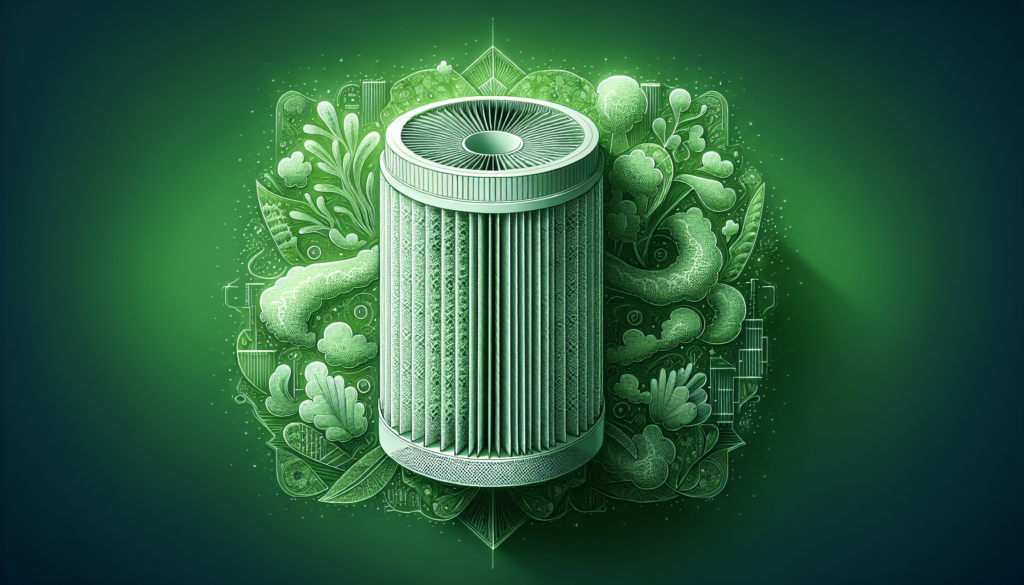Maintaining clean and fresh air in your home is essential for a healthy and cozy living environment. But have you ever wondered how often you should change your air purifier filter to ensure optimal performance? The answer may surprise you. In this article, we will explore the factors that determine the frequency of filter changes, providing you with insights and tips to keep the air in your home as pure as can be. So let’s uncover the secrets behind the question of how often you should change your air purifier filter.

Factors to consider
When it comes to changing the filter in your air purifier, there are several factors to consider. These factors can help determine the optimal time for a filter change, ensuring that your air purifier continues to effectively remove pollutants from your indoor air. Let’s explore these factors in more detail.
Air quality
The first factor to consider is the air quality in your home or office. If you live in an area with high levels of outdoor air pollution or have indoor air quality issues such as mold or pet dander, you may need to change your air purifier filter more frequently. On the other hand, if you live in an area with relatively clean air and have minimal indoor air pollutants, you may be able to go longer between filter changes.
Type of air purifier
Another important factor to consider is the type of air purifier you have. Different air purifiers use different types of filters, and each type has its own lifespan. Understanding the lifespan of your specific filters will help you determine the appropriate time for a filter change. The most common types of filters include HEPA filters, activated carbon filters, and pre-filters.
Usage frequency
The frequency at which you use your air purifier also plays a role in determining when to change the filter. If you use your air purifier daily for extended periods of time, the filter is likely to get clogged with pollutants more quickly. On the other hand, if you only use your air purifier occasionally, you may be able to extend the filter lifespan.
Manufacturer’s recommendation
Lastly, it’s important to consider the manufacturer’s recommendation for filter changes. The manufacturer of your air purifier will provide specific guidelines on when to change the filter based on the model and type of filter used. It’s important to follow these recommendations to ensure the optimal performance of your air purifier.
Signs that indicate a filter change
It’s not always easy to determine when it’s time to change the filter in your air purifier. However, there are several signs you can look out for that indicate a filter change is needed. By recognizing these signs, you can ensure that your air purifier continues to provide you with clean and fresh indoor air.
Decreased air flow
One of the most obvious signs that it’s time to change your air purifier filter is a noticeable decrease in air flow. If you feel like the air coming out of your air purifier is not as strong as it used to be, it could indicate that the filter is clogged and no longer able to effectively remove pollutants from the air.
Increased allergy symptoms
If you or your family members start experiencing an increase in allergy symptoms, it could be a sign that the filter in your air purifier is no longer effectively capturing allergens. Allergens such as pollen, dust mites, and pet dander can accumulate on the filter over time, reducing its ability to provide relief from allergies.
Dusty or dirty filter
A visual inspection of the filter can also help determine if a filter change is necessary. If your filter appears dusty or dirty, it’s a clear indication that it has reached its capacity and needs to be replaced. A dirty filter not only reduces the efficiency of your air purifier but also allows trapped pollutants to recirculate in your indoor air.
Unpleasant odor
If you start noticing a musty or unpleasant odor coming from your air purifier, it could be a sign that the filter needs to be changed. A dirty filter can become a breeding ground for bacteria and mold, leading to unpleasant odors. Changing the filter will help eliminate these odors and ensure that your air purifier continues to provide clean and fresh smelling air.
Standard filter lifespan
Understanding the standard lifespan of different types of air purifier filters can help you plan for regular filter changes. Let’s take a closer look at the typical lifespan of three common types of air purifier filters: HEPA filters, activated carbon filters, and pre-filters.
HEPA filters
HEPA (High-Efficiency Particulate Air) filters are considered the gold standard when it comes to air purification. These filters are capable of capturing particles as small as 0.3 microns, including dust, pollen, pet dander, and mold spores. On average, HEPA filters can last anywhere from six months to a year, depending on usage and air quality.
Activated carbon filters
Activated carbon filters play a crucial role in removing odors and harmful gases from the air. These filters are composed of activated carbon, which has a high surface area that can trap and absorb pollutants. Activated carbon filters typically last around six months to a year, depending on the level of odors and chemicals in the air.
Pre-filters
Pre-filters are the first line of defense in an air purifier and are designed to capture larger particles such as dust and pet hair. These filters are usually washable and reusable, but their lifespan can vary depending on how frequently they are cleaned. On average, pre-filters can last between three to six months before needing replacement.
It’s important to note that these are general guidelines, and the actual lifespan of your filters may vary. Be sure to consult the manufacturer’s recommendation for your specific air purifier model.
High pollution areas and specific needs
Living in high pollution areas or having specific needs such as pets or respiratory conditions can also affect the frequency of filter changes. Let’s explore how these factors can impact the maintenance of your air purifier.
Urban locations
If you live in an urban area with high levels of outdoor air pollution, your air purifier’s filter may get clogged more quickly. The increased presence of pollutants like vehicle emissions and industrial pollutants can result in a higher concentration of airborne particles in your home. In such cases, it is advisable to change your air purifier filter more frequently to maintain optimal air quality.
Pet owners
Pet owners know all too well the challenges of dealing with pet hair, dander, and odors. These allergens can accumulate on your air purifier filter, decreasing its effectiveness over time. If you have pets, it is recommended to change your air purifier filter more frequently to ensure that you and your furry friends can breathe cleaner air.
People with respiratory conditions
Individuals with respiratory conditions such as asthma or allergies are more sensitive to airborne pollutants. For these individuals, it is crucial to maintain clean indoor air to avoid triggering respiratory symptoms. Changing the air purifier filter regularly is essential in reducing the presence of allergens and irritants in the air, helping to alleviate symptoms and improve overall respiratory health.
By considering these specific needs and environmental factors, you can determine whether you need to change your air purifier filter more frequently to address your unique air quality concerns.

Environmental impact
While air purifiers play an important role in improving indoor air quality, it’s also essential to consider their environmental impact. Regularly changing air purifier filters can result in increased landfill waste, contributing to environmental pollution. However, there are eco-friendly filter options available that can help minimize this impact.
Landfill waste
Traditional air purifier filters are often made of non-biodegradable materials, such as synthetic fibers and plastics. When these filters are disposed of, they can take hundreds of years to decompose in landfills. This accumulation of waste has a significant impact on the environment. Therefore, finding alternative solutions to reduce the amount of waste generated by air purifier filters is crucial for a sustainable future.
Eco-friendly filter options
Fortunately, manufacturers are increasingly offering eco-friendly filter options that aim to reduce the environmental impact of air purifier filters. These filters are often made of biodegradable or recyclable materials, ensuring that they can be disposed of more responsibly. Additionally, some filters can be cleaned and reused, minimizing waste generation. When choosing an air purifier, it’s worth considering models that offer eco-friendly filter alternatives to help reduce your carbon footprint.
How to determine the right time for a filter change
Determining the right time for a filter change can sometimes be challenging. However, there are several methods you can use to ensure that you change your air purifier filter at the right time. Let’s explore these methods in more detail.
Check the manufacturer’s instructions
The manufacturer’s instructions are a valuable resource when it comes to determining the right time for a filter change. These instructions often provide specific guidelines based on the model and type of filter used in your air purifier. By following these instructions, you can ensure that you change the filter at the recommended intervals.
Observe the air purifier’s performance
Monitoring your air purifier’s performance can also help indicate when a filter change is necessary. If you notice a decline in the air purifier’s ability to remove pollutants or a decrease in air flow, it may be time for a filter replacement. Regularly observing and assessing your air purifier’s performance will help you identify any changes that could indicate a filter change is needed.
Use air quality sensors or detectors
Air quality sensors or detectors can provide real-time information about the air quality in your home. These devices measure the concentration of pollutants in the air, giving you a clear indication of when the air purifier filter needs changing. By monitoring the air quality regularly, you can ensure that your filter is changed at the right time to maintain a healthy indoor environment.
Regular maintenance schedule
Establishing a regular maintenance schedule for your air purifier can help you stay on top of filter changes. Set reminders or mark a calendar to ensure that you replace the filter at the recommended intervals. Following a maintenance schedule will help optimize the performance of your air purifier and ensure that you and your family can enjoy clean and fresh indoor air.
Frequency recommendations for common scenarios
The frequency at which you should change your air purifier filter can vary depending on your specific circumstances. Here are some frequency recommendations for common scenarios to help guide you in determining the optimal filter change schedule.
General household use
For general household use, it is typically recommended to change your air purifier filter every six to twelve months. This timeframe allows for regular maintenance and ensures that the filter remains effective in capturing pollutants from the air. However, factors such as air quality, usage frequency, and the type of filter used may also influence the frequency.
Allergy sufferers
If you or someone in your household suffers from allergies, it is advisable to change the air purifier filter more frequently. Allergens such as pollen, dust mites, and pet dander can accumulate on the filter, reducing its ability to provide relief from allergy symptoms. Changing the filter every three to six months may be necessary to maintain optimal air quality.
High pollution areas
Living in high pollution areas may necessitate more frequent filter changes. The increased presence of pollutants in the air can quickly clog the filter, reducing its effectiveness. If you live in such areas, consider changing your filter every three to six months to ensure that your air purifier continues to provide clean and healthy indoor air.
Pet owners
Pet owners should also consider more frequent filter changes due to the presence of pet hair, dander, and odors. These allergens can accumulate on the filter, hindering its ability to remove pollutants from the air. Changing the filter every three to six months is recommended for pet owners to maintain optimal air quality.
Smoking environments
In smoking environments, it is essential to change the air purifier filter more frequently due to the presence of smoke and its associated pollutants. Smoke particles can quickly clog the filter and compromise its performance. Changing the filter every three to six months in smoking environments is advisable to effectively remove smoke-related pollutants from the air.
By taking these scenarios into account, you can adjust your filter change frequency accordingly to meet your specific needs.
DIY filter maintenance and cleaning
Proper maintenance and cleaning of your air purifier filter can help extend its lifespan and ensure optimal performance. Although filters generally need to be replaced, there are some steps you can take to maintain and clean them. Let’s explore some DIY filter maintenance techniques.
Vacuuming the filter
For filters that are not washable, vacuuming is an effective method to remove loose dust and debris. Use a vacuum cleaner with a brush attachment to gently vacuum the surface of the filter. Be careful not to use excessive force to avoid damaging the filter. Regular vacuuming can help prolong the lifespan of your filter between replacements.
Rinsing or washing filters
Some filters, such as pre-filters or washable filters, can be rinsed or washed to remove trapped particles. Consult the manufacturer’s instructions to determine if your filter is washable and the appropriate cleaning method. Typically, washing the filter with mild soap and water or using a gentle spray can help remove dirt and restore its efficiency. Ensure that the filter is completely dry before reinstalling it.
Using compressed air
Compressed air can be used to remove debris and dust from filters with fine mesh or delicate materials. Carefully direct the compressed air across the filter surface to dislodge any trapped particles. Be cautious not to use excessive pressure, as it could damage or deform the filter. Compressed air can help remove superficial contaminants and revive the filter’s performance.
Replacement versus cleaning
While cleaning and maintenance techniques can help extend the lifespan of your filter, there comes a time when replacement becomes necessary. Filters that are visibly dirty, damaged, or have reached the end of their recommended lifespan should be replaced. Regular replacement of filters is crucial in maintaining optimal air quality and ensuring the effective operation of your air purifier.
Benefits of regular filter changes
Regularly changing your air purifier filter offers several benefits that contribute to a healthier and cleaner indoor environment. Let’s explore these benefits in more detail.
Improved air quality
The primary benefit of regular filter changes is improved air quality. By replacing the filter at the recommended intervals, you ensure that your air purifier continues to effectively capture and remove airborne pollutants. This improves the overall air quality in your home or office, providing you with cleaner and fresher air to breathe.
Enhanced air purifier efficiency
A clean and properly functioning filter allows your air purifier to operate at maximum efficiency. When the filter is clogged or dirty, it strains the air purifier’s motor and fan, reducing its effectiveness. Regular filter changes help maintain the efficiency of your air purifier, ensuring that it operates optimally to remove airborne pollutants from your indoor environment.
Reduced allergy symptoms
For individuals with allergies or asthma, changing the air purifier filter regularly is essential in reducing allergy symptoms. A clogged or dirty filter can recirculate allergens and irritants in the air, triggering respiratory issues. By replacing the filter as recommended, you alleviate the presence of allergens and create a healthier environment for allergy sufferers.
Prolonged lifespan of the air purifier
Regular filter changes can also help extend the overall lifespan of your air purifier. When the filter is not replaced regularly, the air purifier has to work harder to compensate for the reduced filtering capacity. This additional strain can lead to premature wear and tear of the unit. By maintaining a regular filter change schedule, you help prolong the life of your air purifier, saving you money in the long run.
Conclusion
Maintaining a clean and healthy indoor environment is crucial for your overall well-being. Regularly changing the filter in your air purifier is an essential part of ensuring optimal air quality. By considering factors such as air quality, usage frequency, type of air purifier, and manufacturer’s recommendations, you can determine the appropriate time for a filter change.
Recognizing signs such as decreased air flow, increased allergy symptoms, dusty or dirty filters, and unpleasant odors can help indicate when a filter change is necessary. Understanding the standard lifespan of different types of filters, such as HEPA filters, activated carbon filters, and pre-filters, can guide you in planning for regular maintenance.
High pollution areas, specific needs such as pet ownership or respiratory conditions, and environmental impact are additional factors to consider when determining filter change frequency. By following recommended guidelines and adhering to a regular maintenance schedule, you can optimize the performance of your air purifier and enjoy cleaner and fresher indoor air.
Lastly, consider the benefits of regular filter changes, such as improved air quality, enhanced air purifier efficiency, reduced allergy symptoms, and the prolonged lifespan of your air purifier. By staying proactive in maintaining your air purifier filters, you can create a healthier and more comfortable living environment for you and your loved ones.

